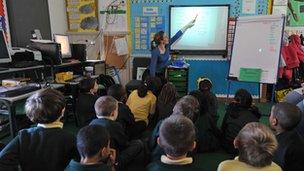Infant classes over 30 almost treble in five years
- Published

Some 72,000 four-to-seven-year-olds are in classes of 30 and above, according to official data
The number of four-to-seven-year-olds being taught in classes of more than 30 pupils almost trebled in five years, according to official data.
Some 72,000 infant pupils in England are now in large classes, up from 24,700 in 2008, suggests data from the Department for Education (DfE).
The previous government banned classes of more than 30 for this age group, unless under exceptional circumstances.
A DfE spokeswoman said classes often fall back to 30 "after a year or two".
A rising birth-rate and more immigration have led to a shortage of primary school places in England. In March, the National Audit Office predicted a need for an extra 240,000 primary places by next year.
'Real strain'
The spending watchdog said that one in five primary schools was full or near capacity with signs of "real strain" on places.
In 2008, there were 730 infant classes with more than 30 pupils, representing 1.7% of the total.
By 2013, this had risen to 2,299 "over-sized" classes, 4.1% of the total.
The jump has been particularly sharp in the past year. In January 2013 an extra 24,645 infants were being taught in over-sized classes compared with January 2012. This represents an increase of 52%.
The average infant class now stands at 27.3 pupils, up from 27.2 in 2012 and 25.7 in 2008, according to the figures.
The coalition government relaxed rules brought in under Labour which said that if a class went over 30 pupils it had to be brought down to below the limit the following year, except under exceptional circumstances.
The current rules allow schools to have larger classes for longer under a wider range of circumstances, for example to accommodate children from military families.
The government says the most common reason for over-sized classes is admissions panels allowing appeals by parents.
Schools expand
A DfE spokeswoman said the government expected an extra 190,000 school places to have been created by September.
"Children are only permitted to join classes of 30 pupils in exceptional cases, if, for instance, they are in care or from military families. Classes often fall back naturally to 30 over a year or two.
"We are spending £5bn by 2015 on creating new school places, more than double the amount spent by the previous government in the same time frame. We are also building free schools and letting the most popular schools expand to meet demand from parents."
Russell Hobby of the National Association of Head Teachers said: "Primary schools are beginning to experience pressure on places from the population boom and this is leading to larger infant classes.
"Class size is not the be-all-and-end-all for education standards. Other factors matter more, but very large classes are neither safe nor productive."
- Published1 April 2013
- Published15 March 2013
- Published22 June 2011